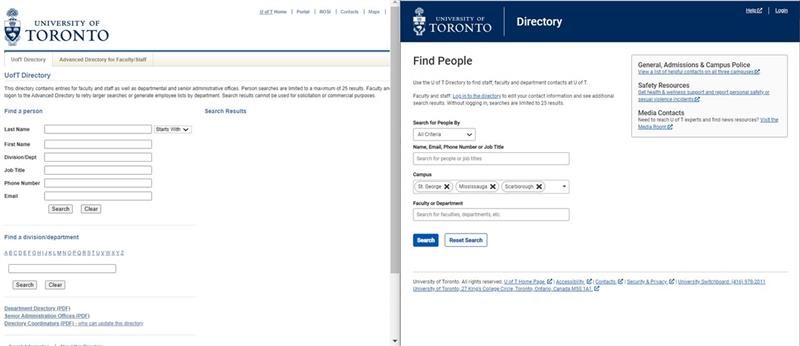After extensive research and design activities, an overhaul of the database architecture, customization for different user groups and the launch of four modules, the U of T phonebook directory project has officially wrapped up – providing users a more modern, accurate and mobile-friendly application.
The revamped phonebook directory allows external and internal users to search for staff, faculty members and division or department information using an accessible interface. It also eases Departmental Administrators’ workloads, since staff and faculty can update secondary information.
“We’ve really worked to improve data accuracy and user experience,” says Pamela Harris, associate director of Enterprise Applications & Solutions Integration (EASI). “It provides a lot of convenience – from using the application on a mobile device to allowing staff and faculty to update important parts of their information.”
This project was initiated in fall 2019 and was a collaboration between Information Technology Services and Human Resources & Equity.
Staff and faculty can log in using their UTORid and add additional phone numbers and an alternate U of T email. They can also select which phone number and email they would like to use to receive official Human Resources communications. Departmental administrators log in to their own module to primarily maintain department-specific contact information.
And when business officers cannot edit information, including creating a new department and modifying the visibility of that department, a module allows telecommunications administrators access to edit information and add new business officers to the system.
Before the team began any design work, they conducted research with staff across all three campuses to understand their thoughts on the current directory and possible improvements.
“I attended one of the initial usability testing workshops for the phonebook redesign project, where the team had set up a prototype of the actual application,” says Nathan Harrison, product delivery lead at Arts & Science Information and Instructional Technology. “It was so much easier to provide feedback on specific tasks with this approach – you’re able to provide richer feedback, and having your voice heard helps to make an enterprise change feel more inclusive for end-users.”
Similar to Google, the site takes the guesswork out of searching by providing autosuggestions, and guides people through the searching process with helpful tips. It also displays helpful information from all three campuses, including emergency, media and safety contacts.
“A key difference between the old and new application is the enhanced search functionality,” says Laura Klamot, a user experience designer with EASI. “Previously, it was more difficult for users to find what they were looking for since they might not remember a person’s full name, or be familiar with all of the department and faculty names, as well as the structure of the University. We worked hard to create an all-encompassing search.”
A new search feature allows departmental and telecommunications administrators to search by UTORid. And while users can compile a list of departmental contacts in a PDF, they can now download an easily editable CSV file.
Accessibility was also a major focus of the project. The team built the application according to accessibility standards (WCAG 2.1), and tested it using a collection of browsers, devices, and screen reader software.

Beyond the user interface, the data accuracy in the new phonebook has also been greatly improved.
“The previous application relied on directory coordinators to update a lot of the information and the data became easily outdated and sometimes inaccurate,” says Na Young Lee, assistant to the director at Arts & Science Information and Instructional Technology. “Since the information is pulled from the Human Resources Information System (HRIS) and various other databases, we can trust that it’s current data.”
Brian Galvis, lead phonebook directory project manager with EASI agrees.
“The new phonebook directory integrates data from many systems, including U of T’s VoIP provider, UTORauth, HRIS, University of Toronto Scarborough and the University of Toronto Mississauga. The magic of it is that all of those databases and systems come together behind the scenes to provide faster data exchanges and an overall improved user experience.”
With the ability to scale in the future, the phonebook could integrate with other university systems.
“The team has accomplished a lot with this project and we have a solid platform for potential future upgrades,” says Pamela Harris. “This could include integration with even more University of Toronto resources, such as Campus Maps, MS Outlook, and an Emergency Contact application.”
Interested in learning more about the Authenticated Search and Departmental Administrator Modules? Visit https://easi.its.utoronto.ca/initiatives/phonebookdirectory/ for a training video, FAQs and other resources.

